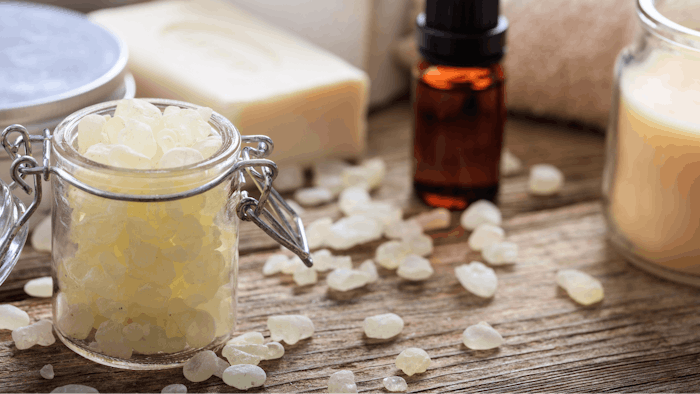
Herbal remedies rooted in Ayurveda and Traditional Chinese Medicine have attracted consumers for decades, especially now, amidst the trends for slow beauty and self-care. Despite modern medical and technological advances, traditional medicine speaks to a primal desire to find solutions in nature and to make a nostalgic connection with the ancient past. This demand for herbal medicine will only grow larger – the market is expected to expand from $165.66 billion in 2022 to $347.50 billion by 2029 (a CAGR of 11.16%).1
Mastic has a place within this space. This aromatic resin from the Pistacia lentiscus or mastic tree has captured the attention of the Ancients throughout history.2 For example, as far back as 5,000 years ago, Egyptians used mastic to flavor a type of sausage called Mombar Mahshy, which has been found in ancient tombs.3
The mastic tree traditionally grows on the island of Chios in Greece. The oozing sap or residue from this plant forms tear-shaped droplets, earning mastic the nickname tears of Chios. Upon extraction, the mastic dries and forms translucent pieces of resin that, when chewed, soften and become a bright white, opaque gum with a pine or cedar flavor.2 In fact, the word mastic has the same roots as the English masticate, which means “to gnash one’s teeth.”3
The first mention of mastic “tears” was in ancient Greece by Hippocrates, the father of medicine, who reportedly used the material to prevent digestive problems and colds, and as a breath freshener. The Romans used it with honey, pepper and egg in the spiced wine conditum paradoxum. The Roman physician Galen prescribed it for bronchitis and to improve blood, and in India and Persia, it was used to fill dental cavities.3 Mastic is also still used as a flavoring agent mainly in bakery products, confectionery, jams, ice cream, chocolate, beverages, tea and liquors.4
Related: The New Environmental Protection Plan
Beauty and Health Applications
Mastic has had many medicinal uses throughout antiquity, but was also used in beauty applications. Dioscorides, writing in the first century A.D., reported Greek women using the resin to attach false eyelashes. During the Ottoman Empire, members of the sultan’s harem were said to have freshened their breaths and whitened their teeth with it.3 It was additionally used as a cosmetic agent for cleaning the face and body, as an active ingredient in: creams, ointments, cosmetic waters/perfumes, masks, mouthwashes, dietary supplements (tablets, digestive capsules, powders, etc.), and other pharmaceutical formulations.4
One source recently reported there is substantial evidence linking mastic’s benefits to its anti-inflammatory and anti-oxidative properties.5 Additional claims include acting as an oral antiseptic by targeting harmful bacteria, reducing cholesterol, and imparting antimicrobial, antifungal, antioxidant, anti-inflammatory and anti-cancer properties.3,6 Recognizing its therapeutic value, the European Medicines Agency even included mastic in the category of traditional herbal medicines, approving its use for mild dyspeptic disorders and for inflammation or minor lesions of the skin.6,7,8
Read more about the skin benefits of mastic in April's Digital Magazine...
Rachel Grabenhofer is the managing scientific editor of Cosmetics & Toiletries, Skin Inc.’s sister brand for cosmetic chemists. She’s a member of the Skin Microbiome Council and Society of Cosmetic Chemists, and for several years, led judging panels to honor the best ingredients in cosmetics.











